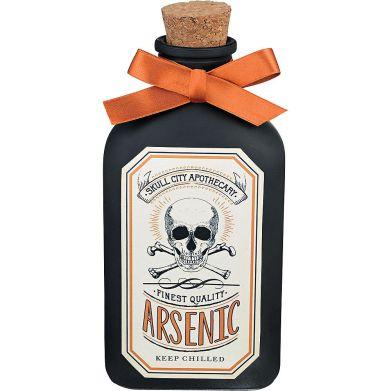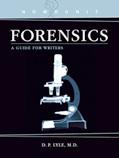 Criminal Mischief: Episode #16: Arsenic: An Historical and Modern Poison
Criminal Mischief: Episode #16: Arsenic: An Historical and Modern Poison
SHOW NOTES: http://www.dplylemd.com/criminal-mischief-notes/16-arsenic-an-historical.html
PAST SHOWS: http://www.dplylemd.com/criminal-mischief.html

From HOWDUNNIT:FORENSICS
Toxicology is a relatively new science that stands on the shoulders of its predecessors: anatomy, physiology, chemistry, and medicine. Our knowledge in these sciences had to reach a certain level of sophistication before toxicology could become a reality. It slowly evolved over more than two hundred years of testing, starting with tests for arsenic.
Arsenic had been a common poison for centuries, but there was no way to prove that arsenic was the culprit in a suspicious death. Scientist had to isolate and then identify arsenic trioxide-the most common toxic form of arsenic- in the human body before arsenic poisoning became a provable cause of death. The steps that led to a reliable test for arsenic are indicative of how many toxicological procedures developed.
1775: Swedish chemist Carl Wilhelm Scheele (1742-1786) showed that chlorine water would convert arsenic into arsenic acid. He then added metallic zinc and heated the mixture to release arsine gas. When this gas contacted a cold vessel, arsenic would collect on the vessel's surface.
1787: Johann Metzger (1739-1805) showed that if arsenic were heated with charcoal, a shiny, black "arsenic mirror" would form on the charcoal's surface.
1806: Valentine Rose discovered that arsenic could be uncovered in the human body. If the stomach contents of victims of arsenic poisoning are treated with potassium carbonate, calcium oxide, and nitric acid, arsenic trioxide results. This could then be tested and confirmed by Metzger's test.
1813: French chemist Mathieu Joseph Bonaventure Orfila (1787-1853) developed a method for isolating arsenic from dog tissues. He also published the first toxicological text, Traité des poisons (Treatise on Poison), which helped establish toxicology as a true science.
1821: Sevillas used similar techniques to find arsenic in the stomach and urine of individuals who had been poisoned. This is marked as the beginning of the field of forensic toxicology.
1836: Dr. Alfred Swaine Taylor (1806-1880) developed the first test for arsenic in human tissue. He taught chemistry at Grey's Medical School in England and is credited with establishing the field of forensic toxicology as a medical specialty.
1836: James Marsh (1794-1846) developed an easier and more sensitive version of Metzger's original test, in which the "arsenic mirror" was collected on a plate of glass or porcelain. The Marsh test became the standard, and its principles were the basis of the more modern method known as the Reinsch test, which we will look at later in this chapter.
As you can see, each step in developing a useful testing procedure for arsenic stands on what discoveries came before. That's the way science works. Step by step, investigators use what others have discovered to discover even more.
Acute vs. Chronic PoisoningAt times the toxicologist is asked to determine whether a poisoning is acute or chronic. A good example is arsenic, which can kill if given in a single large dose or if given in repeated smaller doses over weeks or months. In either case, the blood level could be high. But the determination of whether the poisoning was acute or chronic may be extremely important. If acute, the suspect list may be long. If chronic, the suspect list would include only those who had long-term contact with the victim, such as a family member, a caretaker, or a family cook.
So, how does the toxicologist make this determination?
In acute arsenic poisoning, the ME would expect to find high levels of arsenic in the stomach and the blood, as well as evidence of corrosion and bleeding in the stomach and intestines, as these are commonly seen in acute arsenic ingestion. If he found little or no arsenic in the stomach and no evidence of acute injury in the gastrointestinal (GI) tract, but high arsenic levels in the blood and tissues, he might suspect that the poisoning was chronic in nature. Here, an analysis of the victim's hair can be invaluable.
Hair analysis for arsenic (and several other toxins) can reveal exposure to arsenic and also give a timeline of the exposure. The reason this is possible is that arsenic is deposited in the cells of the hair follicles in proportion to the blood level of the arsenic at the time the cell was produced.
In hair growth, the cells of the hair's follicle undergo change, lose their nuclei, and are incorporated into the growing hair shaft. New follicular cells are produced to replace them and this cycle continues throughout life. Follicular cells produced while the blood levels of arsenic are high contain the poison, and as they are incorporated into the hair shaft the arsenic is, too. On the other hand, any follicular cells that appeared while the arsenic levels were low contain little or no arsenic.
In general, hair grows about a half inch per month. This means that the toxicologist can cut the hair into short segments, measure the arsenic level in each, and reveal a timeline for arsenic exposure in the victim.
Let's suppose that a wife, who prepares all the family meals, slowly poisoned her husband with arsenic. She began by adding small amounts of the poison to his food in February and continued until his death in July. In May he was hospitalized with gastrointestinal complaints such as nausea, vomiting, and weight loss (all symptoms of arsenic poisoning). No diagnosis was made, but since he was doing better after ten days in the hospital, he was sent home. Such a circumstance is not unusual since these types of gastrointestinal symptoms are common and arsenic poisoning is rare. Physicians rarely think of it and test for it. After returning home, the unfortunate husband once again fell ill and finally died.
As part of the autopsy procedure, the toxicologist might test the victim's hair for toxins, and if he did, he would find the arsenic. He could then section and test the hair to determine the arsenic level essentially month by month. If the victim's hair was three inches long, the half inch closest to the scalp would represent July, the next half inch June, the next May, and so on until the last half inch would reflect his exposure to arsenic in February, the month his poisoning began. Arsenic levels are expressed in parts per million (ppm).
An analysis might reveal a pattern like that seen in Figure 11-1.
IMAGE in HOWDUNNIT: FORENSICS
The toxicologist would look at this timeline of exposure and likely determine that the exposure occurred in the victim's home. The police would then have a few questions for the wife and would likely obtain a search warrant to look for arsenic within the home.
LINKS:
Arsenic Poisoning (2007): CA Poison Control: https://calpoison.org/news/arsenic-poisoning-2007
Arsenic Poisoning Cases Wikipedia: https://en.wikipedia.org/wiki/Arsenic_poisoning_cases
Arsenic" a Murderous History: https://www.dartmouth.edu/~toxmetal/arsenic/history.html
Facts About Arsenic: LiveScience: https://www.livescience.com/29522-arsenic.html
Poison: Who Killed Napolean?: https://www.amnh.org/explore/news-blogs/on-exhibit-posts/poison-what-killed-napoleon
Victorian Poisoners: https://www.historic-uk.com/HistoryUK/HistoryofEngland/Victorian-Poisoners/
12 Female Poisoners Who Killed With Arsenic: http://mentalfloss.com/article/72351/12-female-poisoners-who-killed-arsenic
